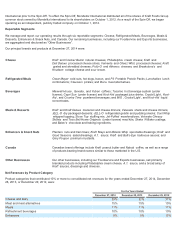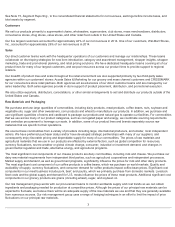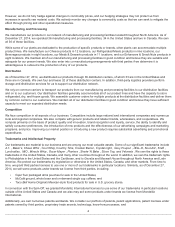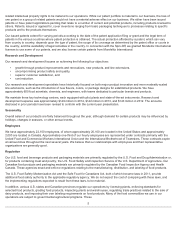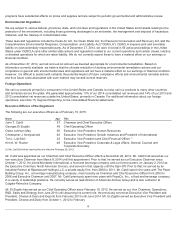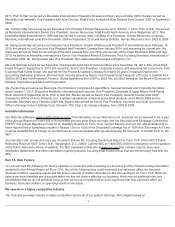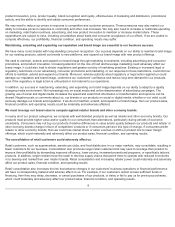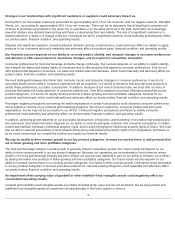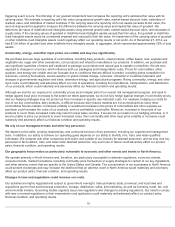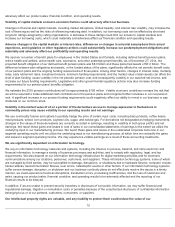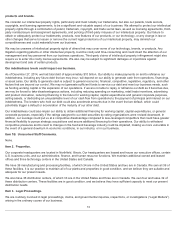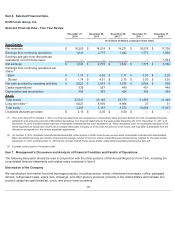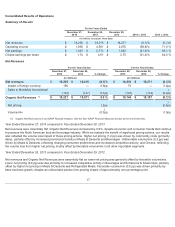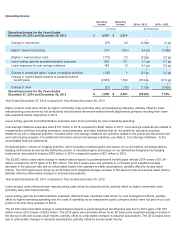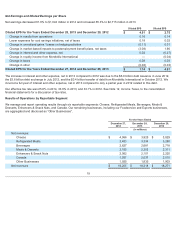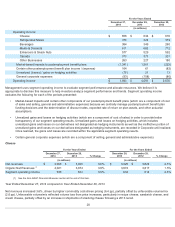Kraft 2014 Annual Report Download - page 15
Download and view the complete annual report
Please find page 15 of the 2014 Kraft annual report below. You can navigate through the pages in the report by either clicking on the pages listed below, or by using the keyword search tool below to find specific information within the annual report.
Legal claims or other regulatory enforcement actions could subject us to civil and criminal penalties.
As a large food and beverage company, we operate in a highly regulated environment with constantly evolving legal and regulatory
frameworks. Consequently, we are subject to heightened risk of legal claims or other regulatory enforcement actions. Although we
have implemented policies and procedures designed to ensure compliance with existing laws and regulations, there can be no
assurance that our employees, contractors, or agents will not violate our policies and procedures. Moreover, a failure to maintain
effective control processes could lead to violations, unintentional or otherwise, of laws and regulations. Legal claims or regulatory
enforcement actions arising out of our failure or alleged failure to comply with applicable laws and regulations could subject us to
civil and criminal penalties that could materially and adversely affect our product sales, reputation, financial condition, and operating
results.
Product recalls or other product liability claims could materially and adversely affect us.
Selling products for human consumption involves inherent legal and other risks, including product contamination, spoilage, product
tampering, allergens, or other adulteration. We could decide to, or be required to, recall products due to suspected or confirmed
product contamination, adulteration, misbranding, tampering, or other deficiencies. Product recalls or market withdrawals could
result in significant losses due to their costs, the destruction of product inventory, and lost sales due to the unavailability of the
product for a period of time. We could be adversely affected if consumers lose confidence in the safety and quality of certain food
products or ingredients, or the food safety system generally. Adverse attention about these types of concerns, whether or not valid,
may damage our reputation, discourage consumers from buying our products, or cause production and delivery disruptions.
We may also suffer losses if our products or operations violate applicable laws or regulations, or if our products cause injury,
illness, or death. In addition, our marketing could face claims of false or deceptive advertising or other criticism. A significant
product liability or other legal judgment or a related regulatory enforcement action against us, or a significant product recall, may
materially and adversely affect our reputation and profitability. Moreover, even if a product liability or fraud claim is unsuccessful,
has no merit, or is not pursued, the negative publicity surrounding assertions against our products or processes could materially
and adversely affect our product sales, financial condition, and operating results.
Unanticipated business disruptions could adversely affect our ability to provide our products to our customers.
We have a complex network of suppliers, owned manufacturing locations, co-manufacturing locations, distribution networks, and
information systems that support our ability to consistently provide our products to our customers. Factors that are hard to predict or
beyond our control, like weather, raw material shortage, natural disasters, fire or explosion, terrorism, generalized labor unrest, or
health pandemics, could damage or disrupt our operations or our suppliers’ or co-manufacturers’ operations. These disruptions may
require additional resources to restore our supply chain or distribution network. If we cannot respond to disruptions in our
operations, whether by finding alternative suppliers or replacing capacity at key manufacturing or distribution locations, or are
unable to quickly repair damage to our information, production, or supply systems, we may be late in delivering, or unable to
deliver, products to our customers and may also be unable to track orders, inventory, receivables, and payables. If that occurs, our
customers’ confidence in us and long-term demand for our products could decline. Any of these events could materially and
adversely affect our product sales, financial condition, and operating results.
We may not successfully identify or complete strategic acquisitions, alliances, divestitures or joint ventures.
From time to time, we may evaluate acquisition candidates, alliances or joint ventures that may strategically fit our business
objectives or we may consider divesting businesses that do not meet our strategic objectives or growth or profitability targets.
These activities may present financial, managerial, and operational risks including, but not limited to, diversion of management’s
attention from existing core businesses, difficulties integrating or separating personnel and financial and other systems, inability to
effectively and immediately implement control environment processes across a diverse employee population, adverse effects on
existing or acquired customer and supplier business relationships, and potential disputes with buyers, sellers or partners. In
addition, to the extent we undertake acquisitions, alliances or joint ventures or other developments outside our core geography or in
new categories, we may face additional risks related to such developments. For example, risks related to foreign operations include
compliance with U.S. laws affecting operations outside of the United States, such as the Foreign Corrupt Practices Act, currency
rate fluctuations, compliance with foreign regulations and laws, including tax laws, and exposure to politically and economically
volatile developing markets. Any of these factors could materially and
11


